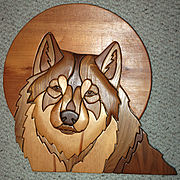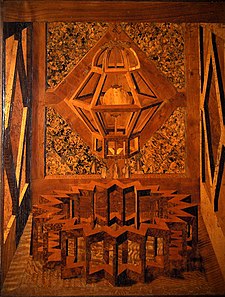Intarsia
From Wikipedia, the free encyclopedia
- This article is about the form of wood inlaying. For the knitting technique, please see Intarsia (knitting).
Intarsia is a form of wood inlaying that is similar to marquetry. The term is also used for a similar technique used with small, highly polished stones (see pietre dure). The technique of intarsia inlays sections of wood (at times with contrasting ivory or bone) within the solid matrix; by contrast marquetry assembles a pattern out of veneers upon the carcase. The technique of intarsia is believed to have developed in the Islamic world; introduced into Europe through Sicily, the art was perfected in Siena and in northern Italy in the fifteenth and sixteenth centuries, spreading to German centers and introduced into London by Flemish craftsmen in the later sixteenth century. After about 1620, marquetry tended to supplant intarsia in urbane work.
It is the craft of using varied shapes, sizes and species of wood fitted together to create an almost 3-D inlaid, mosaic-like picture. It is thought that the word 'intarsia' is derived from the Latin word 'interserere' which means "to insert" and that it was originally developed in Siena, Italy in the 13th century by crafters using inlays of ivory inserted in wood as well as inlays of wood inserted into wall murals, table tops and other furniture (See : Duomo di Siena).
Today, intarsia is created by selecting different types of wood, using its natural grain patterns and colors (rather than dyes and stains) to create the different colors in the pattern. Each piece of wood is then individually cut , shaped, and sanded before fitting them together like a jig-saw puzzle and gluing them to a piece of 1/4 inch plywood backing cut to the shape of the final product. Sometimes, additional pieces of plywood are used to raise areas of the pattern to create more depth. Once together, a final layer of finish is applied and the project is complete.
Marble intarsia (opere di commessi), called pietra dura in English for the semi-precious hardstones combined with colored marbles that are employed, is an intarsia of coloured stones inlaid in white or black marble. Early examples in Florence date from the mid fifteenth century and reached a peak of refinement and complexity in revetments of the Medici Chapel, produced under Medici patronage in the Opificio delle Pietre Dure, which was established by Ferdinando I de’ Medici. Later complex designs and refinement of the art developed in Naplescirca the beginning of the 17th century The floor of St. Peter's Basilica in Rome is a particularly notable example of marble intarsia. Later this form of decoration became a feature of baroque interior design, particularly so in the Sicilian Baroque designs following the earthquake of 1693.




No comments:
Post a Comment